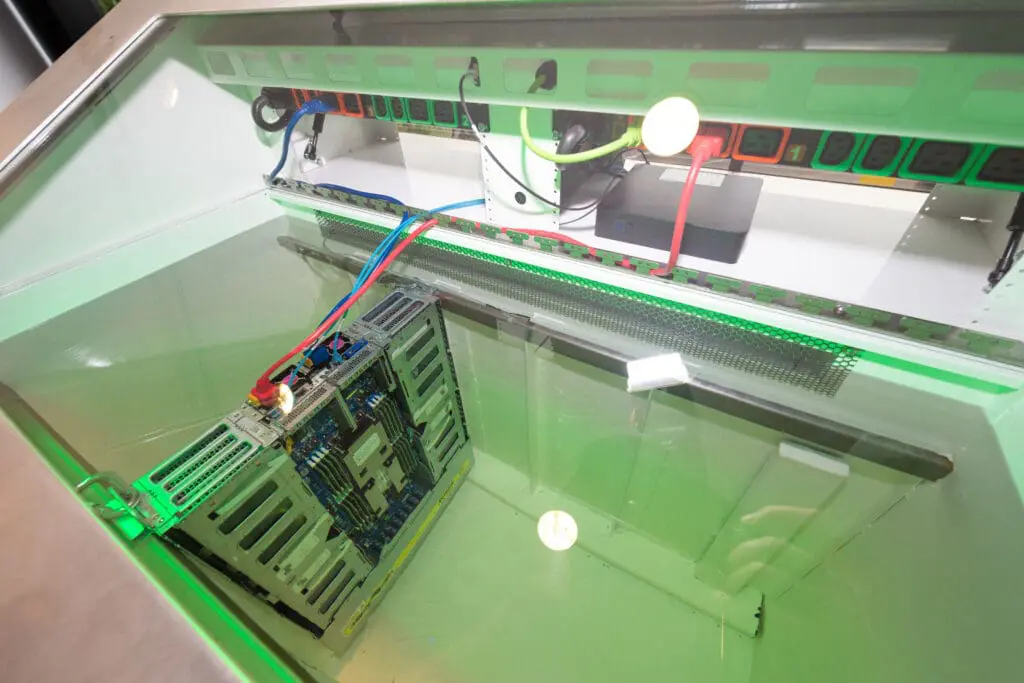Why Immersion Cooling is critical to the AI revolution

What will it take to power the next wave of innovation?
Australia is home to the Southern Hemisphere’s fastest supercomputers and continues to invest heavily in high-performance computing (HPC) infrastructure. But as AI reshapes our world at breakneck speed, the demands on data centres have intensified dramatically.
High-performance computing (HPC) systems — used in fields like scientific research, climate modelling, genomics, and financial services — have long pushed the limits of traditional data centre cooling. These systems rely on powerful CPUs, GPUs, and memory-dense configurations that generate extreme heat. Without effective thermal management, performance suffers due to throttling and energy waste.
Immersion cooling solves this by enabling HPC systems to run at full capacity over extended periods, unlocking the kind of compute power needed for advanced research and discovery.
“HPC isn’t just powering AI. If anything, it’s underpinning everything from cancer research to space modelling. And to keep that momentum going, we need infrastructure that can keep pace.” - Lizzi Long, General Manager – Sales, DCBC, Interactive
Recognising the growing urgency to support high-density compute, Interactive took early steps to address the cooling challenge.
When Interactive launched its first immersion cooling solution in Sydney in March 2023, the AI boom had yet to hit full throttle. Just two years on, it’s clear that advanced cooling has become one of the most critical enablers of modern AI infrastructure.
“AI is front and centre. We’ve got chips consuming 20 times more power than standard compute. Air cooling just won’t cut it anymore.” – Lizzi Long
From generative AI and machine learning to climate science and genomics, HPC is central to solving humanity’s biggest challenges.
But none of that progress is possible without the infrastructure to support it. That’s where immersion cooling, and liquid cooling more broadly, comes in.

What is liquid cooling – and why does AI need it?
As data centres race to keep up with increasingly dense and power-hungry AI workloads, liquid cooling has become a critical enabler of next-gen infrastructure.
Liquid cooling refers to the use of liquids – such as water or refrigerants – rather than air to remove heat from IT hardware. According to Gartner: “Liquid cooling uses a liquid, such as water or a refrigerant, rather than air, to cool the data centre. This allows the cooling solution to be brought closer to the heat source, thus requiring less, if any, fan power.
“Liquid cooling can solve the high-density server cooling problem, because liquid conducts more than 3,000 times as much heat as air and requires less energy to do so, allowing increased data centre densities. Newer piping technology means the probability of leaks is extremely low.”
There are two primary types of liquid cooling:
- Direct Liquid-to-Chip (DL2C) Cooling: Liquid coolant is delivered directly to the hottest components – typically the CPU and GPU – via cold plates. This allows targeted cooling while maintaining compatibility with existing rack-based data centres.
- Immersion Cooling: Entire servers are submerged in a dielectric (non-conductive) fluid that draws heat away from all components. This enables ultra-high-density compute configurations, making it ideal for advanced AI and HPC environments.
“To cool today’s AI chips, like NVIDIA’s GB200s drawing 138kW, or GB300s nearing 250kW, you need liquid cooling or direct-to-chip solutions. Immersion isn’t just an option anymore. It’s becoming essential.” - Lizzi Long, General Manager – Sales, DCBC, Interactive
Notably, immersion cooling, in particular, is gaining traction because of its ability to manage extreme thermal loads efficiently while lowering cooling-related energy consumption. That efficiency is increasingly vital as power constraints and sustainability pressures rise globally.
How the AI boom changed the cooling conversation
AI workloads are computationally intensive, but they’re also infrastructure-intensive. The chips powering AI models generate massive amounts of heat and require enormous energy to operate. Understandably, that’s creating significant global challenges around:
- Power: Energy consumption is skyrocketing. No country has yet fully solved the power provisioning required for AI-scale compute.
- Real Estate: High-density compute demands more power in less space. Land availability is limited in key markets like Singapore and Australia.
Immersion cooling directly addresses both issues by enabling more compute per square metre and drastically reducing the power needed for cooling.
“It’s not a silver bullet. AI still consumes huge amounts of power. But immersion cooling drastically reduces the power needed to cool those systems, and that matters.” – Lizzi Long
Direct liquid-to-chip vs immersion cooling: What’s the difference?
In some environments, direct liquid-to-chip cooling may be the better fit. It focuses on key heat sources, like processors, and can be integrated into existing infrastructure without major layout changes.
Immersion cooling, on the other hand, involves placing the entire server in a liquid bath. It cools all components uniformly, making it ideal for ultra-high-density workloads and next-gen AI applications that push conventional cooling to its limits.
Ben Taylor, Head of Data Centre Engineering at Interactive, explains: “Liquid cooling solutions allow us to handle 100 kilowatts in a single rack instead of spreading that load across 10 racks. That’s not only cost-effective, it’s a game-changer in efficiency.”
Why immersion cooling is a sustainability play
Let’s face it: Sustainability is no longer a future goal; instead, it’s a core operational imperative. Immersion cooling helps organisations meet ESG objectives by:
- Lowering power usage effectiveness (PUE) to near 1.0
- Reducing reliance on traditional fans and air-circulation systems
- Cutting cooling-related carbon emissions
This is good for the planet, and good for business. Greater efficiency means lower operational costs, longer equipment life, and higher ROI.
Built for resilience
What’s more, liquid cooling isn’t just about managing today’s thermal loads; instead, it’s also a ‘smart investment’ in business continuity. As organisations push further into high-density, always-on infrastructure, reliability is critical.
Certainly, it plays an important role in business continuity and disaster recovery planning.
In fact, downtime due to overheating becomes far less likely when your cooling infrastructure is designed for extreme density.
By reducing dependency on airflow systems and fan-powered cooling, immersion solutions enhance uptime and provide a layer of resilience that air cooling simply can’t match.
Adoption, challenges and misconceptions
While the efficiency and sustainability benefits of immersion cooling are compelling, adoption still faces hurdles. One of the main concerns is perceived risk. Organisations may worry about equipment warranties, integration with existing systems, or the complexity of maintaining unfamiliar infrastructure.
These concerns are understandable, particularly for environments with strict uptime and compliance requirements. However, as more real-world deployments succeed at scale, these misconceptions are being addressed.
The industry is rapidly moving beyond the idea that immersion cooling is niche or experimental. It’s proving itself as a viable, reliable, and increasingly mainstream solution.
Enabling the next wave of innovation
While AI is the most visible driver, immersion cooling also supports vital research and innovation across:
- Genomics and cancer research
- Climate science and modelling
- Astrogation (spacecraft navigation) and orbital dynamics
- Healthcare diagnostics and medical imaging
Australia’s opportunity to lead
Indeed, the APAC region is projected to dominate the global high-density rack market, driven by surging demand for cloud, AI, and research compute. For Australia, this represents a pivotal moment: a chance not just to contribute, but to lead.
The big shift is happening now. Immersion cooling isn’t a future technology. It’s a ‘now’ technology, and if we want to stay competitive, we have to adopt it now.
The bottom line? Immersion cooling is no longer an experimental concept. It’s a proven technology that meets the moment. As AI, HPC, and sustainability converge, organisations that move early will be best positioned to lead, not follow.
If there’s anything I’ve learned in this space it’s this: The future of compute is dense, demanding, and data-driven. And it starts with a smarter way to cool.
“It’s the way of the future – probably one of the biggest leaps in terms of cooling technology that we’ve seen as an industry. It’s an enabler for everything else, breaking the chains that have held us back and letting us really lean into the next stage of computing.” - Freya Yu, Sales Director, Giga Computing
Looking ahead
Immersion cooling is a critical technology for Australia’s research capabilities. It will unlock the full potential of high performance computing, enable more compact and dense hardware configurations, and enable new technologies and applications.
Now is the time to adopt immersion cooling, to put Australia at the forefront of research and development, enabling us to tackle some of the world’s most pressing challenges.
Learn more: https://staging.interactive.com.au/services/data-centres/solutions/high-density/
Unlock the next stage in hyper performance
Interactive’s high-density data centres are intelligently designed to support the next generation of infrastructure.


